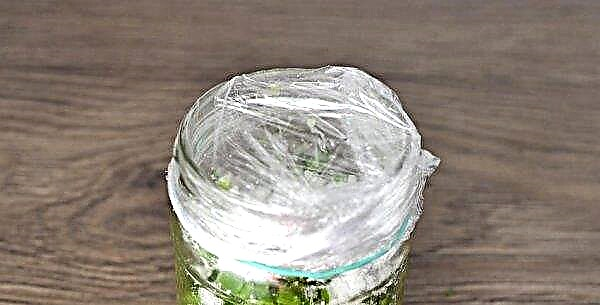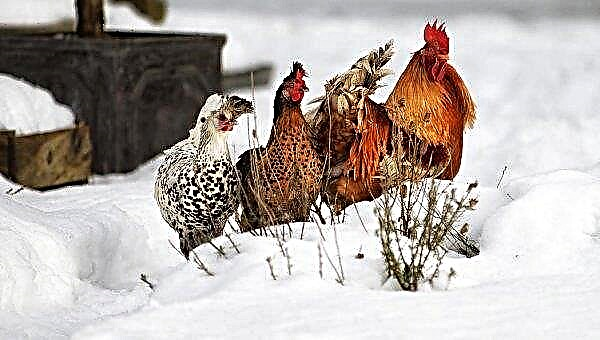The ability to correctly select and fasten a saddle is an important part in caring for a horse. There are many types of saddles, of different sizes and with different designs. You can even do it yourself.
Horse saddle construction
The saddle is a difficult device, with a large number of components. What does it consist of? The main parts:
- lenchik;
- seat (frame);
- front and back bow;
- stirrups;
- Schneller
- wing or fender (at the saddle western);
- saddle pillows.
Did you know? The heaviest stallion in the world is Sampson, who weighed as much as 1520 kg.
Types of saddles
The assertion that the types of horse saddles are equal to the number of types of horses would be incorrect. There are many more. Horseback riding requires a lot of effort from the horse and rider. Sometimes, in order for the animal to gain more speed, sitting must be uncomfortable for the rider. In order to understand how each of them is called, how much it weighs, what they are, you need to spend a lot of time. Below are the main characteristics and differences, weight in kg and the purpose for each type. The first to consider walking.
In order to understand how each of them is called, how much it weighs, what they are, you need to spend a lot of time. Below are the main characteristics and differences, weight in kg and the purpose for each type. The first to consider walking.
Universal walking
This ammunition is intended for all those who value comfort and also want to enjoy measured riding. It is used to overcome medium distances at a leisurely pace, horseback riding. The universal saddle combines the features of two others:
- for dressage;
- for jumping.
Weight varies by model, but is approximately 5 kg.
English
It has no horn and pillows. Depending on the height of the front and rear bows, the length, location or shape of the wings, the depth of the seat, the English is divided into subspecies for the intended purpose:
- tourist;
- for horse polo;
- race;
- hunting;
- competitive;
- ladies' etc.
Weight varies from 4 to 7 kg.
Pack
Designed to transport packs. Its design allows you to evenly distribute and securely secure the load on the horse’s back. Keeps the back from damage, reduces the pressure of the load on the horse’s chest. Light weight, about 2-3 kg.
Shelf
The name comes from the structural features of the saddle. It has two curved boards-shelves. The design was used in ancient times, when the horse was used mainly as a vehicle. Weight can reach up to 15 kg. In turn, it is divided into several types.
Shepherd
Designed to graze cattle while riding a horse. Provides convenience to both the rider and the horse. Weight is about 7 kg.
Ladies
Only suitable for horses with a long back. Designed for women only. It is not advisable to stay in this saddle for a long time, as long journeys cause discomfort to the rider, due to the location of the body. It features long shelves. The weight of the female saddle is up to 8 kg.
Cavalry
The drill saddle is used in military cavalry. The structure allows you to optimally distribute the weight of the rider. Cavalry ammunition weighs about 7–11 kg.
Runner
It has plastic shelves, which greatly facilitates the weight of the device. Designed specifically for runs. Weight - up to 6 kg.
Cossack
The regiments of the Cossack saddle are much shorter than the cavalry. The main purpose of the design is to provide comfort to the rider, but not the horse. Feature - the absence of a leather cover (it is replaced by a soft pillow). It weighs approximately 5–9 kg.
Hunting
Allows the rider to feel the horse, keep an even posture. Does not touch the withers. Weight is about 10 kg.
Officer
It was created for police officers and the army, for use in parades. Nowadays it is mainly used for long trips, riding in the field. Weight - up to 7 kg.
How to choose a saddle for a horse
Among such a large selection of different designs that differ in their unusual design (such as Mongolian or Turkish), there are several basic rules for selecting a saddle. Observing them, you can easily choose what is convenient for both the rider and the horse.
- It is very important to choose a device that is suitable in size. It all depends on the weight of the rider and the parameters of the horse. Often an individual dimensional grid is provided by the manufacturer of the structure.
- It should not interfere with the horse during movement, compress the shoulder blades, dig into the spine and touch the withers.
- It is important to use the subspecies of the saddle for its intended purpose (race - for jumping, dressage - for riding, etc.).
- It is necessary to study the anatomical structure of the horse, its features, perhaps consult a veterinarian.
Important! If after riding you notice damage to the horse’s skin under a saddle or cinch, be sure to treat them with an antiseptic and pick up other ammunition.
How to train a horse to a saddle
Before starting the training of the animal, you need to be sure that:
- she trusts you;
- has already been curbed;
- knows basic commands;
- familiarized with waltrap, herd and bridle.
The horse should be old enough (about 3 years old). Ammunition should be in size, comfortable and of high quality. The training is as follows:
The training is as follows:
- Carefully put the saddle on the horse, without stirrups. Most likely, she will begin to get nervous, but the ammunition cannot be removed, it is necessary to wait until she becomes calmer.
- Tighten the cinch, securing it gradually so that the horse is accustomed to the sensations.
- Walk with him, you can use the occasion or get him on the cord.
- You only need to sit down with the landing step.
- Do not make sudden movements, behave calmly.
- Climbing a step, begin to put pressure on the seat with your hands, gradually transferring all your weight to it.
- After this stage, calmly and measuredly sit in the saddle, stay there for about 15 seconds, get off.
- Repeat the procedure several times.
- Later, you need to bring the horse, sitting on it, so that he felt the rider.
- It’s not worth starting to manage it right away, let it feel freedom.
- After that, you can begin to accustom the horse to the teams already known to her, but controlling the legs and voicing their usual name.
Important! An animal cannot be tied; instead, it is better to ask someone to help hold it.
Video: saddle training, start of race
How to make a saddle for a horse with your own hands
You can try to sew such a complex design with your own hands. It is not easy to do this, you need to make a lot of effort and have patience for this matter. Production consists of several stages, and each of them is very important.
Sizes and pattern
Saddle size is determined by:
- the weight of the rider;
- horse parameters (height at the withers, back length).
The basis of the saddle is a lenchka, for which it is necessary to prepare a pattern (layout).
To make it you will need:
- cardboard;
- 130 cm wire;
- scissors.
 A layout is created according to this scheme:
A layout is created according to this scheme:- Take part of the wire and press it to the horse’s body behind the shoulder blades, where the front of the bow of the lenok is located. The wire should take the shape of the back.
- Then attach it to the cardboard, circle the outline.
- Cut out the layout and try on the horses. It should ideally fit its size.
Materials and tools for work
Material and tools must be of high quality and in good condition. From the materials you will need:
- solid piece of wood, or glued plywood, or fiberglass (optional for a lenok);
- foam for interior upholstery;
- nails
- plywood for the base;
- leather or other strong fabric for external upholstery;
- strong threads.
 The following tools will be needed:
The following tools will be needed:- scissors;
- chisel;
- plane;
- jigsaw;
- sandpaper.
Step-by-step manufacturing instructions
Ammunition can be made in only three stages. Nevertheless, each of them needs to be approached with special painstakingness. It should be understood that a homemade saddle will require repair more often than purchased.
Making a lenok according to the layout
A lench can be created from different materials:
- a tree;
- fiberglass;
- glued plywood.
The most affordable material is considered a solid piece of wood. We consider this case. First of all, you need to perform a series of measurements:
- the highest point of the withers;
- the location of the front bows of the lenok (located 4 cm below the scapula)
- bending of the back (from the withers to the 18th vertebra);
- the lowest part of the back;
- the place where the construction will end (must be above the 18th vertebra).

After that, you can start making a lenok:
- Choose a piece of wood (better than oak) that is suitable for the above parameters.
- Start to shape it using a planer and a chisel.
- You can make a curved lenok using a jigsaw and sandpaper.
This should look like the final result:
Interior upholstery
The most common material for interior upholstery is foam. It wears out quickly enough, but at the same time is very cheap, so replacing it will not hit your wallet. Let's get to work:
- If the foam is not dense, it is necessary to put it in a couple of layers.
- Cut out the necessary shape that fits the parameters of the lenok. The lining should be slightly larger than it.
- After that, we “stuff” the base (plywood, cut according to the parameters) on the lenok.
- Nail the foam rubber to the base. They should be long enough to reach the very lenok.

Exterior upholstery
The final step in making a saddle is to fit it with a leather case or other dense material. They just need to sheathe an already prepared lenok. To increase the safety level of ammunition, fabric mounds can be sewn on the front and rear (they will prevent the rider from falling or sliding off the saddle).
Did you know? The color of the horse has an effect on its character.
How to put a saddle on a horse
Before saddling, it is necessary to clean the horse so that during riding it does not rub or hurt. Follow some rules in the process:
- The first is a wraprap. It must be placed high enough so that it covers part of the withers.
- The pocket should be immediately behind the animal’s foot.
- After that we put on a saddle. Nothing should hang in it, stirrups should be fixed.
- The cinch should lie on top.
- Lay the saddle carefully on the saddle without sharp movements.
- With the help of fastenings, we fix the structure on the tack.
- Then we fix the girth. Take it carefully so as not to hit the horse.
- The wings are under the wing of the saddle, with their help you need to tighten the girth. Sometimes a double cinch is used.
- Tighten it slowly so as not to hurt the horse. Do not overtighten.
- After we lower the stirrups and sit astride.

How to get in the saddle
You can ride a horse both from the ground and from a special step. If the horse is very tall and you are a beginner, be sure to take advantage of the elevation.
Step-by-step instruction
Riding is quite simple, but this process consists of several stages:
- First you need to check whether the saddle is correctly mounted on the animal. If necessary, tighten the cinch. Check if the treadmill has shifted.
- Then you need to adjust the stirrups to your height. The length of the stirrup should be approximately equal to the length of the arm from the wrist to the armpit.
- You need to ride a horse on the left side. Face the horse against the front leg. We intercept the occasion so that it is a little tight. You also need to grab a small part of the mane.
- We insert the left foot into the stirrup on a wide part of the foot. We hold on to the back bow of the seat with our right hand and face it. Then you need to push off with your right foot and throw it over the saddle.
- If after the above manipulations it has shifted, you need to align it by standing on stirrups.
Video: riding a horse
Security measures
Riding is a rather dangerous sport, therefore, even when saddling a horse, it is necessary to remember some safety measures.
- If you are a beginner, be sure to ask someone more experienced to stand nearby and, in which case, help.
- You need to find the right shoes and clothes that fit securely on you.
- Particular attention should be paid to young horses, they must be saddled carefully so that this does not end with injuries.
How to remove a saddle from a horse
To remove ammunition from a horse is quite simple:
- First you need to pull up the stirrups.
- After that, disconnect the girth from the body by unfastening the straps under the wing of the saddle.
- Carefully stick your hand under the saddle, lift and pull it off the horse without sudden movements.
- At the end, remove the tandem.
 Without a saddle it is impossible to imagine equestrian equipment, therefore, its proper selection and use is so important.
Without a saddle it is impossible to imagine equestrian equipment, therefore, its proper selection and use is so important.












